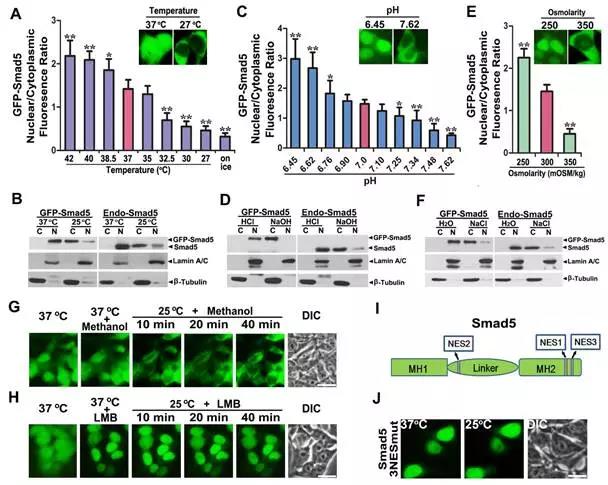On July 4, 2017, Professor Zhang Xiaoqing's from the
shanghai Tenth People's Hospital and Professor Zhang Xiaoqing from School of
Medicine at Tongji University published a latest research results titled
"Smad5 acts as an intracellular pH messenger and maintenance" in Cell
Research magazine, a well-known international academic journal.
Organisms
are always in a constantly changing environment inside and outside the cell,
such as temperature, intracellular and extracellular pH and osmotic pressure. Therefore,
all living organisms need to feel and respond to these changing internal and
external environments in order to maintain their normal physiological
functions. Zhang Xiaoqing team researchers accidentally discovered in the
experiment, located in the downstream of the classical BMP signaling pathway
transcription factor Smad5 can feel temperature, extracellular pH and osmotic
pressure changes. High temperature, extracellular acidification and hypotonic
conditions will promote the accumulation of Smad5 in the nucleus; while in low
temperature, extracellular alkaline and hypertonic conditions, Smad5 will
rapidly transfer from the nucleus to the cytoplasm. Further study found that
temperature, extracellular pH and osmotic pressure can cause changes in
intracellular pH, Smad5 can quickly feel changes in intracellular pH and then
cause changes in the distribution of its nuclear plasma. In addition, knockdown
of Smad5 causes steady-state energy disturbances in the cell and disrupts
normal developmental processes. Smad5 binds to HK1, the first rate-limiting
enzyme in glycolysis, enhancing the enzymatic activity of HK1 and accelerating
glycolytic and subsequent oxidative phosphorylation of mitochondria. Therefore,
Smad5 can quickly capture the subtle changes in intracellular pH, through the
nuclear plasma shuttle to regulate intracellular energy homeostasis.
This
study, for the first time, reveals that Smad5 has a completely new and
important function independent of traditional BMP signaling. It is also the
first to discover how cells respond to changes in the external environment and
to maintain intracellular metabolic homeostasis by capturing intracellular pH
changes in important cytology events. This study enhances our understanding of
how intracellular pH and metabolic homeostasis are established and maintained,
raising our awareness of the role of intracellular pH and metabolism in
embryonic development and laying firm groundwork for further drug development,
cell transplantation and treatment Foundation.
Dr.
Xiang-Bin Zhang from Tongji University Medical School, researcher Liu Ling and
Dr. Novobin from Novartis Biomedical Research Center are co-authors of this
paper. The first author of the paper is Professor Fang Xiaoqing Ph.D. Fang
Yujiang students are also recipients of the Ministry of Education academic
newcomer award, and on behalf of Chinese graduate students attended the 2014
Lin Island Nobel Prize winner conference. In this study, Professor Yang Yi and
Zhao Yuzheng from East China University of Science and Technology and Professor
Jin Guohua from Nantong University made important contributions in the
discussion of intracellular pH measurement and related mechanisms.

